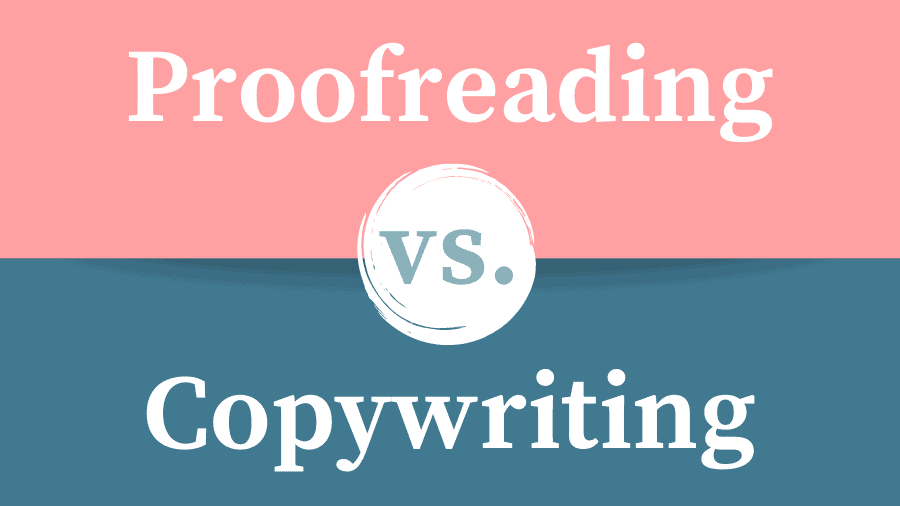This article may contain affiliate links. Please see our affiliate disclaimer in the footer menu for more information. Thank you for your support!

Working as a proofreader, I often encounter people who don’t understand what I do. With all the seemingly similar terminology, it’s no wonder people get confused about the differences between proofreading and copywriting.
Proofreading looks at the final draft of a document to find and fix errors and inconsistencies in grammar, punctuation, spelling, capitalization, and formatting. Copywriting involves writing words to create a text (copy), usually used for advertising, that will persuade people to take a specific action.
Although understanding what’s meant by proofreading will be clear after giving you some information, the term copywriting tends to be more confusing. Copywriting frequently gets confused with other words like copyediting, content writing, and copyright.
Proofreading vs. Copywriting
What Is Proofreading?
Proofreading involves polishing the text written by any kind of writer—maybe even a copywriter. Proofreaders are the last ones to see a document before it reaches its intended audience.
In terms of editing a document, the traditional editorial process consists of four stages:
- developmental editing
- line editing
- copyediting
- proofreading
A document starts with a developmental editor who looks at the big picture. It then goes to a line editor and then to a copy editor.
Finally, a proofreader uses their keen attention to detail to spot any lingering errors before the written work goes public.
In addition to looking for grammar, capitalization, punctuation, spelling, and formatting errors, a proofreader keeps their eyes peeled for repeated or omitted words. They also ensure words are used correctly, especially the ones that go undetected by spell-check.
Homophones (e.g., two, too, and to) are the usual suspects that fly under the radar, failing to trip the not-so-clever spellcheckers that don’t consider context.
If you’d like a more in-depth explanation about proofreading, please see this article I wrote. In this post I also elaborate on the four stages of the editorial process.
What Is Copywriting?

Have you ever read a product description and decided that the product is a must-have? Wait a second. Just a few minutes ago, you were merely entertaining the idea of owning that item, but now you’ve decided that living without it just wouldn’t be in your best interest.
What happened? You just read the words of a savvy copywriter: a creative soul who has a wonderful way with words. They used their crafty copy to cleverly convince you to take action—to buy that product.
Copywriters typically create written content for advertising.
This content is designed to sell a product or service or get the reader to take some other action: click on a link, subscribe to an email list, sign up for a free trial of something, etc.
Many people refer to copywriting as salesmanship in print. Dan Lok—a serial entrepreneur, marketing mastermind, best-selling author, and educator—defines copywriting as “closing in print.”
A successful copywriter has a solid grasp of the psychology of motivation.
Understanding the underpinnings of motivation allows them to write engaging and persuasive copy that motivates people to act.
If writing for the web, copywriters often inject keywords into the text naturally to improve search engine optimization.
In summary, a copywriter writes the words to create compelling text. A proofreader eliminates the errors from the text written by a copywriter (or any type of writer).
Copywriting Is Different from Copyediting, Content Writing, and Copyright
Copyediting
As mentioned earlier, copyediting is the third step in the editorial process.
A copy editor works to make the written word correct, comprehensive, consistent, clear, and concise.
They also correct mistakes with syntax (sentence structure). Although copy editors also address the same errors as proofreaders (grammar, spelling, punctuation, etc.), their focus is broader than a proofreader’s.
Whereas a proofreader works at the word level of a document, a copy editor works at the sentence level.
I wrote an article about how proofreading and copyediting differ if you’d like to know more.
I also penned a post that discusses the differences between copyediting and copywriting.
Content Writing
A content writer is someone who writes to inform an audience.
They educate readers about a particular topic through content like e-books, newsletters, articles, blog posts, etc. This differs from a copywriter’s job to persuade an audience to take a specific action.
Copyright
What do copywriting and copyright have in common? The short answer is nothing. The long answer is that copywriting and copyright do not have anything in common. 😉
According to the Merriam-Webster.com Dictionary, copyright is “the exclusive legal right to reproduce, publish, sell, or distribute the matter and form of something (such as a literary, musical, or artistic work).”
The © symbol shows that someone’s work is protected by copyright.
Who Hires Proofreaders and Copywriters, and What Kinds of Projects Do They Work On?

Proofreaders are hired by anyone or any company that creates written content for others and, therefore, could benefit from having a proofreader make their content look more professional and refined.
Here are examples of individuals who hire proofreaders:
- business owners
- bloggers
- publishing houses
- entrepreneurs
- transcriptionists
- self-publishing authors
- scriptwriters
- job seekers with résumés
- undergrad and grad students
Proofreaders work on a wide variety of documents, including the following:
- books and e-books
- newsletters
- press releases
- essays
- transcripts
- magazine articles
- blog posts
- newspapers
- résumés
- screenplays
- catalog descriptions
- user manuals
- theses
- website copy
Copywriters are hired by any person or business that needs written content that will compel someone to act and, therefore, could benefit from a copywriter who can create engaging and persuasive copy.
Here are examples of people who hire copywriters:
- copywriting agencies
- public relations firms
- marketing agencies
- publishing companies
- advertising agencies
- entrepreneurs/ business owners
Copywriters create many types of texts, including the following:
- posts for social media
- brochures
- billboards
- websites
- emails
- sales letters
- taglines
- jingle lyrics
- catalogs
- newspaper and magazine ads
- scripts for commercials
What Kind of Training Do Proofreaders and Copywriters Receive?
Even though you can find proofreaders and copywriters without formal training, the most successful people in these fields tend to be those who have committed themselves to learning their trade.
Although some copywriters have an innate understanding of psychology and a natural ability to write engaging and influential copy without formal training, this is the exception to the rule.
And finding a competent proofreader without formal training is a tall order. Proofreading relies more on a skill set that needs to be developed, whereas copywriters can depend on their creativity and persuasiveness (in addition to learned skills).
Proofreaders and copywriters can find reputable online classes that adequately prepare them for a career in their respective fields.
I’ve written an article that goes over excellent training options for proofreaders and discusses whether becoming a certified proofreader is possible.
Even though proofreaders don’t learn anything about copywriting in their training, many enjoy writing in some capacity since they tend to love words. I write my website copy and all my blog posts because it’s something I enjoy doing.
Alternatively, copywriters will likely learn a bit about proofreading in their training.
How Much Money Do Proofreaders and Copywriters Make?
Let’s see how much proofreaders and copywriters generally earn. Of course, these numbers will vary based on one’s training, experience, and expertise.
The data below shows salaries earned by proofreaders and copywriters in the United States.
All numbers are from 2025 except those from the Bureau of Labor Statistics (BLS), which are from May 2023.
Average Salaries of Proofreaders and Copywriters Working for US Companies
| Proofreaders | Copywriters | |
|---|---|---|
| BLS | $51,100 | Not Given |
| Payscale | $50,694 | $60,336 |
| Zippia | $49,392 | $65,162 |
| ZipRecruiter | $57,520 | $76,412 |
I wrote an article discussing how much proofreaders make (including freelance proofreaders) and the factors determining their pay if you’re interested in knowing more.
I hope this post helped you clarify the differences between proofreading and copywriting. Maybe some of those commonly confused terms related to copywriting make more sense now too.
Best wishes to you!
“If we had a rampant epidemic of self-love then our health care costs would go down dramatically.”
– Dr. Christiane Northrup

Recent Posts
Punctuation is important because it enables us to communicate our message clearly and effectively. Without punctuation, we wouldn’t understand how units of a sentence relate to one another or how...
Although you're probably somewhat familiar with adverbs, you may be unaware of sentence adverbs. As a trained proofreader who has studied the parts of speech, I can help you understand this unique...
